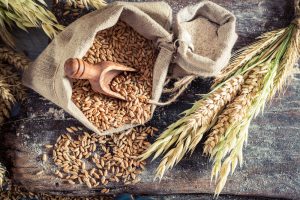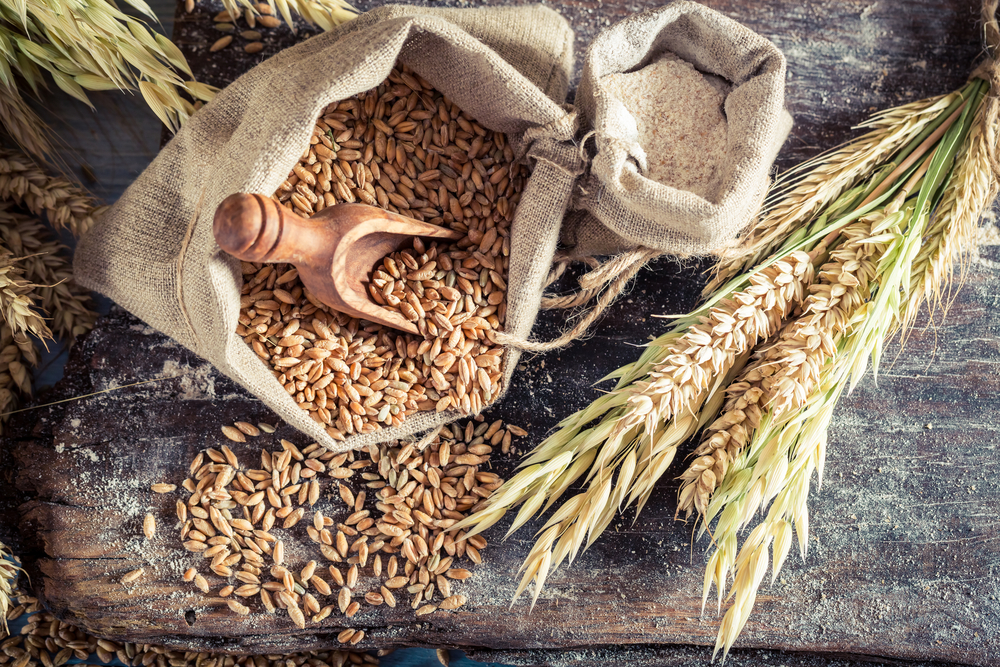In the wide world of dogs, there are debates aplenty. To buy or rescue? To train with treat lures or not train with treat lures? To let your doggo roam off-leash or keep them restrained? One of the most hotly contested is the decision whether to feed your furbaby regular or a grain-free diet for dogs.
Regular food containing grains has long been the most familiar option. But, in the last few years, grain-free dog food has surged in popularity. If you’re wondering if you, too, should go against the grain, we’ve put together a few of the pros and cons of each one to help you decide.

Yep, it’s a photo of grains. Frankly, we don’t know what else you were expecting.
What exactly is grain-free dog food?
Regular dog food usually contains a combination of grains like corn, rice, wheat, barely, oats, rye, and soy. Grain-free dog food, on the other hand, is simply any kind of dog food made without these grains.
Grains are a good source of carbohydrates for dogs. So, grain-free foods often use ingredients such as peas, lentils, potatoes, sweet potatoes, or cassava to up the carb count.
When it comes to grain-free food, the label mostly applies to bags of kibble. Everything from puppy food to kibble designed for different-sized breeds is available, with a range of meat and vegetable blends on offer. However, you’ll also come across grain-free canned food and fresh meals, as well as grain-free dog treats.
Why do some Dog Owners choose grain-free?
Grain-free diets have become increasingly popular in recent years, for both puppers and their people. With humans trending towards diets like paleo and keto, several experts believe that lots of Owners have opted to switch to a grain-free diet for their dogs, too.
The main argument behind choosing grain-free dog food is that it more closely mirrors a dog’s natural diet. Grain-free diet advocates say that dogs are carnivores and should only eat meat – as they do in the wild. Many also believe that regular dog foods are too high in carbohydrates, and that they can cause allergies in dogs.
In actual fact, though, dogs are omnivores. This means that they get their nutrition from both animal and plant sources, including grains. As well, humans have been domesticating dogs for over 10,000 years. In that time, our canine companions have adjusted quite well to eating grain-filled foods. (With some exceptions, which we’ll get to shortly.)
And when it comes to carbs, some grain-free foods actually have a higher carbohydrate content than regular dog foods. This can lead to weight gain if your doggo eats too much.
What are the advantages of food with grains in it?
First, let’s take a look at regular dog food. While some have given it a bad rap, regular, grain-filled dog food has lots of merits.
Grains are very nutritious for dogs
Many grain-free diet proponents deem grains as “fillers”, but they’re actually excellent sources of nutrients for dogs. Grains contain fibre, carbohydrates, and even protein. And because many of them are complex carbs – like brown rice, for example – they contain slow-release energy that won’t cause blood sugar spikes.
Each type of grain also has its own benefits, too. Corn boasts antioxidants and linoleic acid, or omega-6 fatty acid, which is beneficial to your dog’s overall health. Soy is high in various vitamins, as well as folic acid, essential amino acids, and different antioxidants.
Grain-free foods aren’t without their drawbacks
There are certainly advantages to a grain-free diet, but it’s not without its weaknesses. Firstly, the ingredients in grain-free foods tend to be more energy-dense. This means that if your doggo eats too much, it can lead to long-term health issues like obesity. If you opt for grain-free, you’ll need to monitor your dog’s food intake to ensure they don’t go overboard.
A diet that’s too high in protein can also be problematic. If you mostly feed your dog raw meat or food with an excessive amount of protein, it can put too much pressure on their kidneys and liver. To combat this issue, try to pick grain-free foods that contain the right balance of protein, carbs, vitamins, and minerals.
Regular food can be more affordable
Grain-free dog foods tend to use “boutique” ingredients like kale, quinoa, and other superfoods. They also often contain exotic meats, like kangaroo, wild game, duck, and salmon. Naturally, these ingredients are more expensive – just as they are for us humans.
Most grains used in regular dog food, on the other hand, are pretty inexpensive. This means they’re cheaper to make, which usually translates to a lower retail price.
Grain-free pet foods are also still advertised as a “premium” option. Sometimes, their higher price is simply a reflection of their position in the market.
What are the benefits of grain-free dog food?
With all of this in mind, are there any benefits to giving grain-free dog food to your pupper? For some dogs, there certainly are!
It’s ideal for dogs that do have grain allergies
While the percentage is very small (somewhere around 1 per cent), a number of dogs do suffer from grain allergies. The symptoms can vary between dogs, but typically a dog who can’t tolerate grains may experience dry, flaky or itchy skin; a rash; hair loss; red and inflamed paw pads; ear infections; or digestive issues, including vomiting and diarrhoea.
Your vet can conduct various tests to see if your doggo does indeed have a grain allergy. If they suspect that grains are the culprit, they may advise a grain-free diet.
A grain-free diet for dogs also helps with protein allergies
While grain allergies affect some dogs, protein allergies are actually much more common. This means that certain meats may be triggering an allergic reaction rather than grains.
Grain-free dog foods often use exotic meats that differ from those used in regular foods. So, you may find that switching to a grain-free alternative removes a particular protein from your doggo’s diet. Consequently, this can eliminate the source of the allergic reaction.
Your dog can enjoy a more varied diet
Even if your pupper doesn’t have a protein allergy, adding the different types of meat, vegetables, and carbohydrate sources found in many grain-free foods can expose them to a more varied diet filled with an assortment of vitamins, minerals, and nutrients.
There are many benefits of kangaroo meat, for example, including the fact that it’s the leanest source of red meat, it contains healthy unsaturated fat, and it’s high in iron and zinc. Sweet potatoes offer antioxidants like beta-carotene (good for reducing cancer risk and protecting against heart disease), as well as a bunch of vitamins and minerals. Lentils are high in iron, protein, and fibre.
So, how do I decide which food to buy?
Generally speaking, a healthy dog with no allergies or underlying health issues can safely live on regular food, such as quality dry dog food. In fact, dogs are often best sticking to the food they’re used to. This is because a dietary change can put pressure on their digestive system, unless you introduce the food very slowly.
If you think your dog would benefit from a grain-free diet, you might want to chat to your vet first. They can advise whether it’s necessary for your dog to avoid grains, be it for allergy or other health reasons. Then, if you decide to make the switch, you can slowly start to introduce grain-free options to your doggo’s diet.

